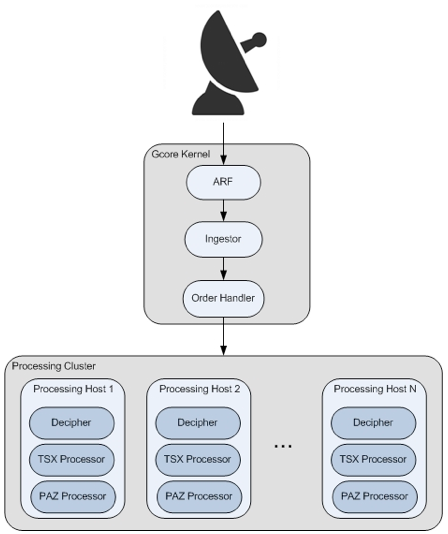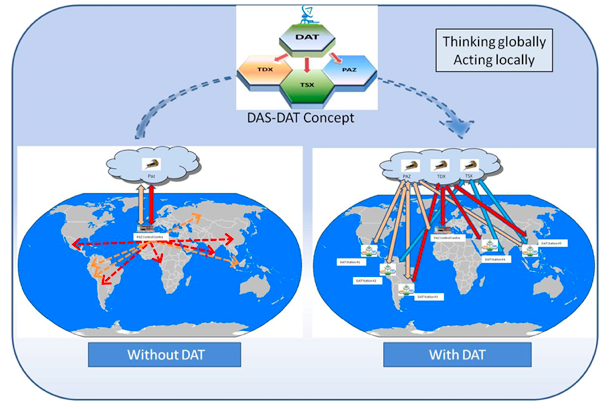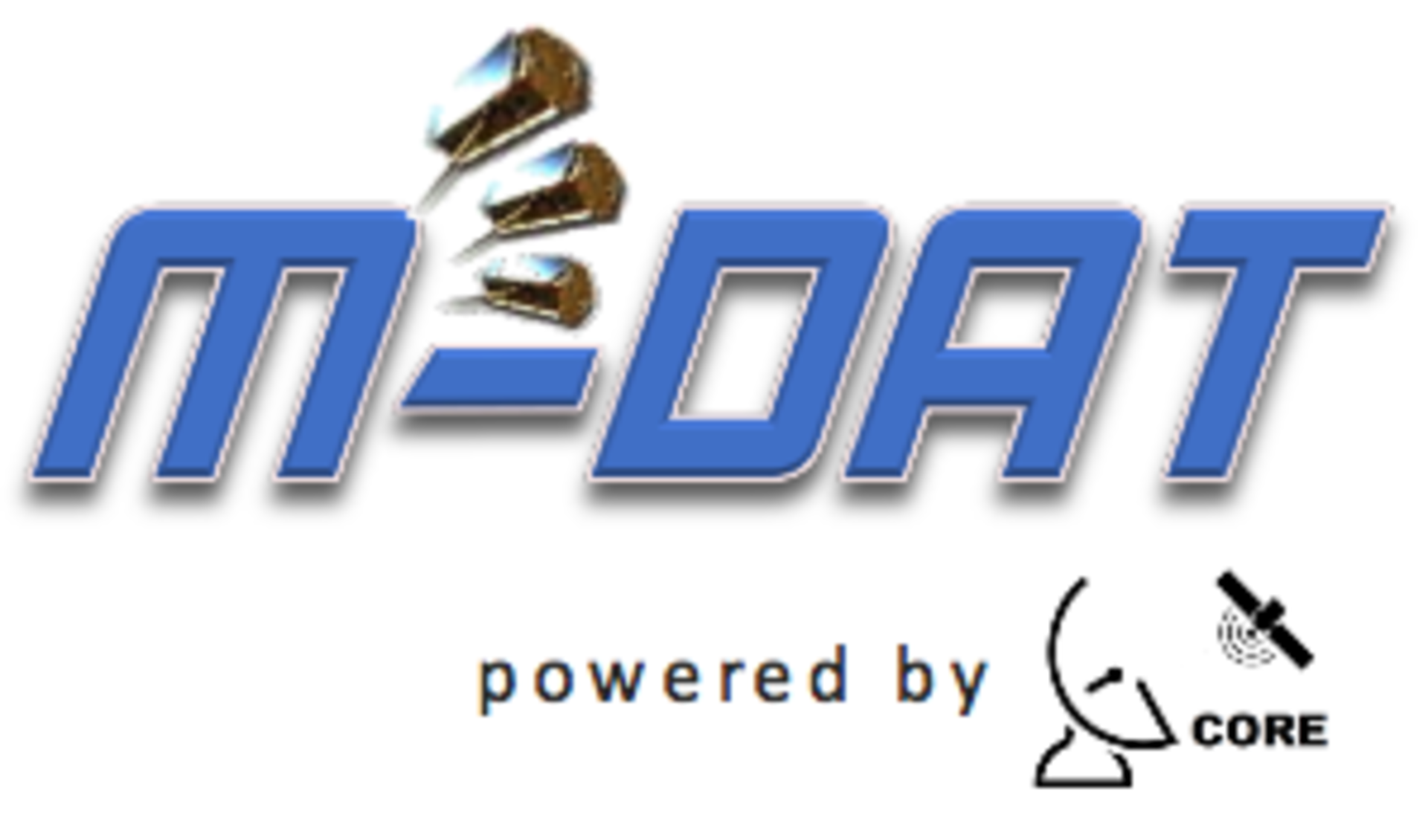Multi-mission Direct Access Terminal for PAZ, TerraSAR-X and other Satellites
GSTP: Make Project: Multi-mission Direct Access Terminal for PAZ, TerraSAR-X and other Satellites
Company |
Country |
Website |
|
| Indra Sistemas S.A. (Prime Contractor) | Spain | http://www.indracompany.com |  |
| Hisdesat Servicios Estratégicos S.A. | Spain | http://www.hisdesat.es |  |
Thinking globally, acting locally: this is the simple idea behind the Multi-mission Direct Access Terminal project for PAZ, TerraSAR-X and Tandem-X satellites.
During the project it has been developed a prototype of a remote processing facility of SAR data, able to receive X-band raw telemetry data of the Joint Constellation and to process them up to standard image products, demonstrating a groundbreaking near-real-time performance also when deployed on the prototype platform.
The scalable design and architecture, in terms of storage area and computing resources, easily allows to give access to the data coming from more future Earth Observation missions, both radar and optical, and to integrate new higher level processors to generate value-added products.
Just deploy an M-DAT, connect it to a compatible X-band ground station antenna equipped with demodulation equipment, and the fastest direct gate to the Joint Constellation data is in your hands.
Project Objectives

The M-DAT project starts from the experience achieved by Indra Sistemas during the design and AIV activities of the PAZ and Ingenio Mission Ground Segments.
The GCORE software product, which is developed, maintained and evolved by the company, is the powerful heart of the proposed data processing system to provide full access to the data generated by the missions PAZ and TerraSAR-X, thanks to the Joint Constellation agreement between HISDESAT and AIRBUS.
Main objective of the DAT is to give to the potential customers the capability to download radar data on their own and to generate standard image products in a very fast way, just a few minutes after the downlink.
System design is fully oriented to optimise the near-real-time performance in order to have quick response times in emergency and crisis situations which require Earth Observation image products. DAT is also designed with the objective to easily integrate additional value-added processors in order to generate higher level products to cover a wider range of SAR data applications.
Data confidentiality is a key driver in order to provide an independent and secure access to huge amount of data, since the target is to build a system able to generate up to 100 image products per day, and to easily upgrade it to manage and process data coming from future missions.
Features

The key features of the developed Multi-mission DAT are:
- Real-time (and offline) telemetry extraction from local and/or remote antennas, ingestion, deciphering and processing of SAR instrument data for the Joint Constellation including PAZ and TerraSAR-X missions
- Generation of standard products SRE, NRT y L1B, from new SAR acquisitions and from local catalogue products
- Multi-mission design, which reduces the cost to add new satellites and will preserve customers’ investment made in the DAT, which can be easily adapted for new missions without the need of procuring additional DATs for each specific mission.
- Flexibility to add higher level processors within the DAT itself to generate value added products from the satellite images. This architecture approach – everything packed in the same system - has important benefits for NRT applications since it shortens the availability time of the higher level products (e.g. a ship detection report).
- Outstanding NRT performance with a distributed computation system: the achieved goal is generating all image products from the raw data downloaded during a satellite contact within few minutes from the downlink.
- Up to 100 standard products can be generated on a daily basis. This image production capacity can be increased (or decreased) through horizontal or vertical scaling depending upon the customer needs.
- Scalable architecture, suitable for the specific customer needs. Scalability can be horizontal (storage improvement and increasing number of processing hosts) and vertical (upgrading HW characteristics).
- Periodical repatriation of the SAR Raw Exchange data to the Mission Ground Segments for central archiving, preserving data confidentiality. The DAT is also capable to locally hide some sensitive products for a given period of time and to later perform exceptional data repatriations.
- Virtualization based solution for easy deployment, ease of maintenance and independence of the HW solution (including refurbishment). Human Machine Interfaces designed with special attention in all details, considering the operators and the users’ specific needs. The goal is to achieve a simple but complete interface, covering all functions in an easy and attractive way.
Project Plan
The activities have been organized in the following three phases:
Phase 1: Requirements Analysis and Preliminary Design
During Phase 1 DAT system requirements were analysed and a preliminary design was carried on. Requirements consolidation was reviewed internally before starting the preliminary design period. It ended at the DAT Preliminary Design Review (DAT-PDR). In that moment the phase was considered completed.
Phase 2: Detailed Design
The purpose of this phase was to consolidate the system design, providing details of the components. DAT elements were defined to a level of detail and understanding such that the implementation and test activities was performed in a straightforward way. The final design of the DAT was reviewed at detailed level in the DAT-CDR review. SW test procedures to be executed at Phase 3 were consolidated and almost ready to be executed. It ended at the DAT Critical Design Review (DAT-CDR). In that moment the phase was considered completed.
Phase 3: Development and Acceptance Testing
Phase 3 mainly concerned software development, testing, troubleshooting, verification and validation activities as foreseen by the Test Plan and the Test Procedures. Software was being coded and progressively integrated into the development platform. The development and unit testing of the DAT and the activities of components integration were executed previously to internal validation activities. The development activities, aimed at correction of SW problems report, have been continuous since completion of Internal Testing until successful completion of DAT-FAT. A FAT test Review has been organized in order to review the validation status of the system after testing campaign.
The system validation has been successfully achieved.
The Final Review took place on 11th of July 2018.
Key Issues
Main issues for the Multi-mission Direct Access Terminal architecture concern the data ageing performance, i.e. most design effort is devoted to shorten processing time and to reduce data transfer and handling delays to the maximum extent.
At the same time, the DAT is conceived as a multi-mission system, with the aim to be easily upgraded and expanded to handle more future EO missions. With this respect, the processing resources can be also expanded to deal with data coming from other ground stations, connected to and remotely commanded by the DAT.
Even if PAZ SAR Processor has not yet been integrated in the system, DAT is basically ready to replace the developed simulator with the real SAR processor. Anyway, the system interfaces are ready to handle PAZ and TerraSAR-X interfaces, and the full processing chain has been verified with TSX mission.
Expected Main Benefits
SAR applications market has been developing in the last years; missions like Sentinel-1, RADARSAT-2, TerraSAR-X/TanDEM-X or Cosmo-SkyMed are expanding the market.
To introduce in the market a Data Access Terminal (DAT) for receiving their own acquired data in the shortest possible time within their Area of Interest (AOI) is a business opportunity
The use of a DAT is addressed to customers who are demanding high amount of products, either images or services, in less time in order to be capable to provide valued added services to potential customers, both civilian and military. The main customers for DAT are the Governments or Institutions and Agencies with national dependencies which dealing to monitor frontiers, coasts, forest, agriculture, surface movements, volcanology, cartography, etc.
Competitive advantages:
- The best commercial spatial resolution in the market, 0.25m.
- Best data latency for NRT acquisitions, thanks to the optimized design of the overall data production chain.
- One of the best revisit time constellations currently in flight.
- The best expected remaining life time for the satellites, considering new satellites included into the constellation.
- An affordable price for a multi-mission concept DAT.
- State of the art technology in the DAT for best customer investment protection.
- Easy integration with local user service system and added-value processor chain, to extend the SAR range of applications offered by the terminal.
The commercialization phase of the prototype will be carried out in parallel with the envisaged short-term evolution roadmap of the terminal, with the ambitious objective to transform it into a more powerful M-CEOS: a Multi-mission Centre for Earth Observation Services. The Services Centre will include the following extra-features, in addition to the already verified M-DAT capabilities and fully integrated with it:
- Higher-level processors integrated into the SAR processing chain, to directly generate in near real time added value services for the final users, or offline starting from the catalogued products.
- Long Term Archive to store all of the mission data received by the M-DAT during the constellation lifetime, allowing to perform historical analyses and time series processing.
- Feasibility Analysis module, to generate satellite acquisition plans in an independent way from the central Service Segment, harmonizing and optimizing requests generated by the different users of the M-CEOS.
- Users Management, specifically addressed to the future constellation Partners, giving them the possibility to provide access to new users, to apply constraint, quotas, assigning priorities, among other functions.
It is noteworthy that each final product will be tailored to the specific Customer needs, thanks to the high versatility of the G-Core suite, the M-DAT engine. Customization will allow integrating the identified extra functions with the aim to offer a wide range of hybrid solutions, from the actual M-DAT up to the fully equipped M-CEOS, available for our customers in the near future.
Current Status (11/7/2018)
The project has been completed with the Final Review held on the 11th of July 2018, having achieved all the objectives of the GSTP Element 2 "Make" contract. DAT SW development has been completed, and the system deployed on the prototype platform at Indra Sistemas premises has been successfully tested, completing all of the integration and validation campaigns foreseen by the project development and testing plans.
Commercialization of operational M-DAT systems is one step closer to start.
Contact
| Project Manager: | Mercedes Rodríguez López | mrodriguezl@indra.es |
| C/ Mar Egeo 4, 28830 San Fernando de Henares (Madrid) | Indra Sistemas S.A. | |
| +34916273296 | +34916273051 | |
| Technical Manager: | Daniele Scaranari | dscaranari@indra.es |
| C/ Mar Egeo 4, 28830 San Fernando de Henares (Madrid) | Indra Sistemas S.A. | |
| +34916273284 | +34916273051 | |
| ESA Technical Officer: | Nicolas Girault | nicolas.girault@esa.int |


